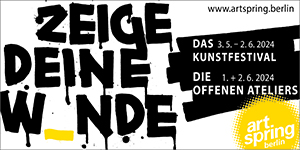The controversial reconstruction of the Berlin Palace demonstrates rapidly changing values within a country still struggling to come to terms with its past. Located in the symbolic city center, the building was a source of national identity, which has become a difficult topic in Germany’s contemporary history. Architectural symbols are economically pertinent in the age of the Global City, in which they also act as a city’s branding logo, drawing in tourists and encouraging investors. Visual language is powerful and artists are especially aware of this: filmmaker Kerstin Honeit is lending her efforts to encourage a wider debate. Her recent video work ‘my castle your castle’ (2017), now playing at Berlinische Galerie, provides a refreshing new perspective on an old story.
Undergoing multiple demolitions and reconstructions, the Berlin Palace seems to have captured all major facets and ruling ideologies of German history. Originally an imperial palace built in the 15th century, with later grandiose Baroque extensions, the Berlin Palace served as a winter residence for the Prussian Kings and German Emperors for around five hundred years. Badly damaged in World War Two, during which many National Socialist parades took place on the grounds, the palace was torn down by the communist GDR in 1950 as a proud rejection of imperialism and nazism. In its place, the GDR erected a Council of State in 1964, expanding into the notoriously ugly and modernist Palace of the Republic in 1973-6.
The Palace of the Republic became a shared, multipurpose site, inviting the public through events, galleries, and performances, where the building’s forward-thinking functionality was prioritised over a show of power and wealth. As Germany reunited, and re-adopted a democratic regime, the Palace of the Republic closed. Demolished in 2006-8, a majority vote held by the Bundestag determined the exterior of the Berlin Palace was to be rebuilt entirely as the original imperial palace, despite several demonstrations protesting the erasure of East German history and identity. While several lobbying groups argued for the need to preserve the lost, beautiful architecture, and its alignment to the neighbouring neoclassical buildings, other intellectuals condemned the expensive endeavour and the selective identity it offered, contrary to a democratic regime.
Gavrel Rosenfeld suggested in an article in The Guardian that the overriding decision to maintain the original imperial architecture stems from an “inability to mourn the past” and demonstrates the intense emotions behind this building. In view of this, the new Berliner Schloss, expected to be completed in 2019, will house the Humboldt Forum’s collections of non-Western art, including artefacts from Germany’s colonial conquests. However, in a quite groundbreaking move, the museum will also highlight forgotten and censored atrocities from Germany’s colonial history. This will include the ethnic cleansing of Namibia, the first genocide of the 20th century, and the Maji Maji rebellion, where 75,000 Tanzanians were killed by German soldiers.
Artist Kerstin Honeit, born in 1977 in a divided Berlin, points out in her video work that the entire debate is inherently elitist. To counter this, she turns her attention to the construction workers physically engaged with the site. Honeit invites Palace of the Republic builder Peter Friedrich, as well as Palace of the Republic demolisher Gunter Teichert, to feature in ‘my castle your castle’ (2017), lending a different connotation to the site. Held in the familiar format of a talk-show—the pop-cultural practise commonly snuffed at by intellectuals—a suited Honeit asks her guests about their opinions on and experiences with the palace. Meanwhile, quotes from positions of authority propagating their opinions on the building are interspersed, and point out the difference in language between these individuals.
Adding absurdity, a pair of singing, queer cowboys also temporarily interrupts the talk-show. It’s an important, intelligent and dryly humorous piece that points out how class divisions and power dynamics skew debate. The construction workers seem not to trust themselves to give opinions on their projects (also due to real, economic consequences such as losing their jobs) and resort to merely describing the work processes, while sheepishly picking at their Kaffee und Kuchen. It’s interesting that Honeit juxtaposes her critique of class by incorporating the informal German institution of coffee and cake, as an intimate, almost embarrassing ritual practised across generations and classes. ‘my castle your castle’ (2016) can be seen at the Berlinische Galerie’s IBB Video Space until July 24, alongside two other video works of Honeit’s, ‘Talking Business’ (2014) and ‘Pigs in Progress’ (2013).
Exhibition Info
BERLINISCHE GALERIE
IBB Video Space
12×12: ‘Kerstin Honeit’
Exhibition: Jun. 28 – Jul. 24, 2017
Alte Jakobstraße 124–128, 10969 Berlin, click here for map























